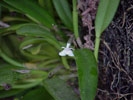|
|
|
|
 |
Email Address Recovery or Password Reset |
Use our Change Password page, and you can set a new password, or if you don't remember which email address you
registered with, the same page may be able to suggest it based on another you enter.
|
|
|
|
|
| |
Flasks of
Cadetia ceratostyloides 'Kosaki' -spontaneous |
|
| |
|
|
| |
| Number: |
TN5748 |
| Name: |
Cadetia ceratostyloides 'Kosaki' -spontaneous
|
| Type: |
spontaneous (What's that?) |
|
Seed Donor: |
Patty Tyler
|
|
Click to Enlarge

Pod Parent Blooming Plant with Capsule |
|
|
|
| |
Culture Notes from Donor: Parent plant: Temperature range I (60-83°F)
Comments: Parent plant: Miniature plant. Identified in 2004 by Selby Gardens as Cadetia ceratostyloides.
For additional origin/habitat information supplied courtesy of
Charles and Margaret Baker, see further below, near the bottom of this page.
|
Temperatures we attempt to use in the lab & greenhouse:
| For Species: |
|
Spring, Summer, Autumn, Winter: days average 82°F, nights 69°F; best fit is Warm-Intermediate 87-64°F
(Source:
Baker's Web OSC) |
|
About the name...
| Etymology of |
Cadetia |
|
Named after Charles Louis Cadet de Gassicourt.
(Source:
Pridgeon 1992) |
| Etymology of |
ceratostyloides |
|
From latinized Greek, means likes the genus Ceratostylis. That name in turn means, "with a horn-like column."
(Sources:
Troy Meyers, Mayr & Schmucker 1998) |
| Pronunciation of |
Cadetia |
|
ka-DET-ee-ah
(Source:
Pridgeon 1992) |
|
If you would like to direct someone to this web page, please copy and paste this URL into your email:
http://troymeyers.com/d?015748
| Flask Information |
| Availability: |
We have sold all of the flasks for this item. |
| You should: |
Consider getting individual plants or compots instead of a flask.
You can place a "Notify Flask Recipients" Request, and either we or a flask recipient may contact you when plants are available.
You may also place a "Notify Retries" Request, and if an identical pollination (the same parents) is done again, we'll let you know.
You may reserve a flask, but it's very unlikely you'll get one ...this could only happen if we found a flask that we didn't know we had. |
| Yield Estimate: |
13 plants (based on flask surveys done 06/08/2007 )
|
| Plantlet Sizes: |
From many flasks 20 - 30 mm plants (based on flask surveys done 03/04/2008 )
From one most recently surveyed flask 20 - 30 mm (03/04/2008)
|
|
You might also want to:
|
View the seed assay for this item.
View items of the same species.
View items of the same genus.
|
| Ordering Information |
| You are not currently logged in. |
|
You must be a registered user and be logged in to reserve a flask or place a notification request. Please log in:
|
|
 |
Email Address Recovery or Password Reset |
Use our Change Password page, and you can set a new password, or if you don't remember which email address you
registered with, the same page may be able to suggest it based on another you enter.
|
|
|
|
|
|
|
|
| |
The origin/habitat information below is supplied courtesy of Charles and Margaret Baker
The following information is based on the name of the plant provided by the donor, and assumes that the name is correct. If the plant has been misidentified, then the following information may not be correct.
This text is copyrighted by the Bakers and may not be reproduced without permission.
ORIGIN/HABITAT: New Guinea. This epiphytic orchid was discovered
originally in Dutch (Western) New Guinea (now Irian Jaya) where it was
growing on the narrow strip of land between Geelvink Bay (now Teluk
Cenderawasih) and the MacCluer Gulf (now Teluk Berau). Habitat elevation
was not reported, but topographical maps indicate that this strip o f land
is rather low-lying, with the maximum elevation being about 2800 ft. (850
m). Habitat elevation has been estimated based on this information, but
the resulting climate table and cultural suggestions should be used
somewhat cautiously until actual elevations are known.
More about this information and the Bakers...
|
|
|
| |
|
|
|